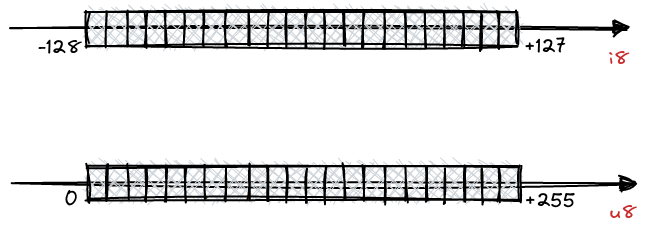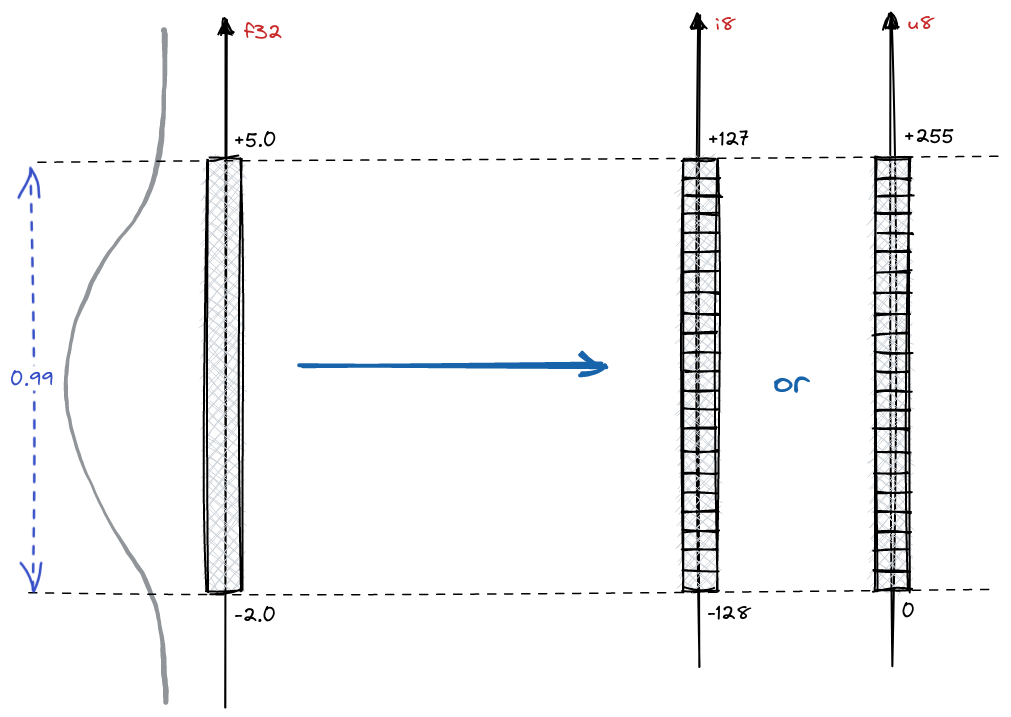Scalar Quantization: Background, Practices & More | Qdrant
Kacper Łukawski
·March 27, 2023

Efficiency Unleashed: The Power of Scalar Quantization
High-dimensional vector embeddings can be memory-intensive, especially when working with large datasets consisting of millions of vectors. Memory footprint really starts being a concern when we scale things up. A simple choice of the data type used to store a single number impacts even billions of numbers and can drive the memory requirements crazy. The higher the precision of your type, the more accurately you can represent the numbers. The more accurate your vectors, the more precise is the distance calculation. But the advantages stop paying off when you need to order more and more memory.
Qdrant chose float32 as a default type used to store the numbers of your embeddings.
So a single number needs 4 bytes of the memory and a 512-dimensional vector occupies
2 kB. That’s only the memory used to store the vector. There is also an overhead of the
HNSW graph, so as a rule of thumb we estimate the memory size with the following formula:
memory_size = 1.5 * number_of_vectors * vector_dimension * 4 bytes
While Qdrant offers various options to store some parts of the data on disk, starting from version 1.1.0, you can also optimize your memory by compressing the embeddings. We’ve implemented the mechanism of Scalar Quantization! It turns out to have not only a positive impact on memory but also on the performance.
Scalar quantization
Scalar quantization is a data compression technique that converts floating point values
into integers. In case of Qdrant float32 gets converted into int8, so a single number
needs 75% less memory. It’s not a simple rounding though! It’s a process that makes that
transformation partially reversible, so we can also revert integers back to floats with
a small loss of precision.
Theoretical background
Assume we have a collection of float32 vectors and denote a single value as f32.
In reality neural embeddings do not cover a whole range represented by the floating
point numbers, but rather a small subrange. Since we know all the other vectors, we can
establish some statistics of all the numbers. For example, the distribution of the values
will be typically normal:

Our example shows that 99% of the values come from a [-2.0, 5.0] range. And the
conversion to int8 will surely lose some precision, so we rather prefer keeping the
representation accuracy within the range of 99% of the most probable values and ignoring
the precision of the outliers. There might be a different choice of the range width,
actually, any value from a range [0, 1], where 0 means empty range, and 1 would
keep all the values. That’s a hyperparameter of the procedure called quantile. A value
of 0.95 or 0.99 is typically a reasonable choice, but in general quantile ∈ [0, 1].
Conversion to integers
Let’s talk about the conversion to int8. Integers also have a finite set of values that
might be represented. Within a single byte they may represent up to 256 different values,
either from [-128, 127] or [0, 255].

Since we put some boundaries on the numbers that might be represented by the f32, and
i8 has some natural boundaries, the process of converting the values between those
two ranges is quite natural:
The parameters f32 and i8.

For the unsigned int8 it will go as following:
In case of signed int8, we’ll just change the represented range boundaries:
For any set of vector values we can simply calculate the
Distance calculation
We do not store the vectors in the collections represented by int8 instead of float32
just for the sake of compressing the memory. But the coordinates are being used while we
calculate the distance between the vectors. Both dot product and cosine distance requires
multiplying the corresponding coordinates of two vectors, so that’s the operation we
perform quite often on float32. Here is how it would look like if we perform the
conversion to int8:
The first term,
If we had to calculate all the terms to measure the distance, the performance could have been even worse than without the conversion. But thanks for the fact we can precompute the majority of the terms, things are getting simpler. And in turns out the scalar quantization has a positive impact not only on the memory usage, but also on the performance. As usual, we performed some benchmarks to support this statement!
Benchmarks
We simply used the same approach as we use in all the other benchmarks we publish. Both Arxiv-titles-384-angular-no-filters and Gist-960 datasets were chosen to make the comparison between non-quantized and quantized vectors. The results are summarized in the tables:
Arxiv-titles-384-angular-no-filters
| ef = 128 | ef = 256 | ef = 512 | |||||
|---|---|---|---|---|---|---|---|
| Upload and indexing time | Mean search precision | Mean search time | Mean search precision | Mean search time | Mean search precision | Mean search time | |
| Non-quantized vectors | 649 s | 0.989 | 0.0094 | 0.994 | 0.0932 | 0.996 | 0.161 |
| Scalar Quantization | 496 s | 0.986 | 0.0037 | 0.993 | 0.060 | 0.996 | 0.115 |
| Difference | -23.57% | -0.3% | -60.64% | -0.1% | -35.62% | 0% | -28.57% |
A slight decrease in search precision results in a considerable improvement in the latency. Unless you aim for the highest precision possible, you should not notice the difference in your search quality.
Gist-960
| ef = 128 | ef = 256 | ef = 512 | |||||
|---|---|---|---|---|---|---|---|
| Upload and indexing time | Mean search precision | Mean search time | Mean search precision | Mean search time | Mean search precision | Mean search time | |
| Non-quantized vectors | 452 | 0.802 | 0.077 | 0.887 | 0.135 | 0.941 | 0.231 |
| Scalar Quantization | 312 | 0.802 | 0.043 | 0.888 | 0.077 | 0.941 | 0.135 |
| Difference | -30.79% | 0% | -44,16% | +0.11% | -42.96% | 0% | -41,56% |
In all the cases, the decrease in search precision is negligible, but we keep a latency reduction of at least 28.57%, even up to 60,64%, while searching. As a rule of thumb, the higher the dimensionality of the vectors, the lower the precision loss.
Oversampling and rescoring
A distinctive feature of the Qdrant architecture is the ability to combine the search for quantized and original vectors in a single query. This enables the best combination of speed, accuracy, and RAM usage.
Qdrant stores the original vectors, so it is possible to rescore the top-k results with the original vectors after doing the neighbours search in quantized space. That obviously has some impact on the performance, but in order to measure how big it is, we made the comparison in different search scenarios. We used a machine with a very slow network-mounted disk and tested the following scenarios with different amounts of allowed RAM:
| Setup | RPS | Precision |
|---|---|---|
| 4.5GB memory | 600 | 0.99 |
| 4.5GB memory + SQ + rescore | 1000 | 0.989 |
And another group with more strict memory limits:
| Setup | RPS | Precision |
|---|---|---|
| 2GB memory | 2 | 0.99 |
| 2GB memory + SQ + rescore | 30 | 0.989 |
| 2GB memory + SQ + no rescore | 1200 | 0.974 |
In those experiments, throughput was mainly defined by the number of disk reads, and quantization efficiently reduces it by allowing more vectors in RAM. Read more about on-disk storage in Qdrant and how we measure its performance in our article: Minimal RAM you need to serve a million vectors .
The mechanism of Scalar Quantization with rescoring disabled pushes the limits of low-end machines even further. It seems like handling lots of requests does not require an expensive setup if you can agree to a small decrease in the search precision.
Accessing best practices
Qdrant documentation on Scalar Quantization is a great resource describing different scenarios and strategies to achieve up to 4x lower memory footprint and even up to 2x performance increase.


